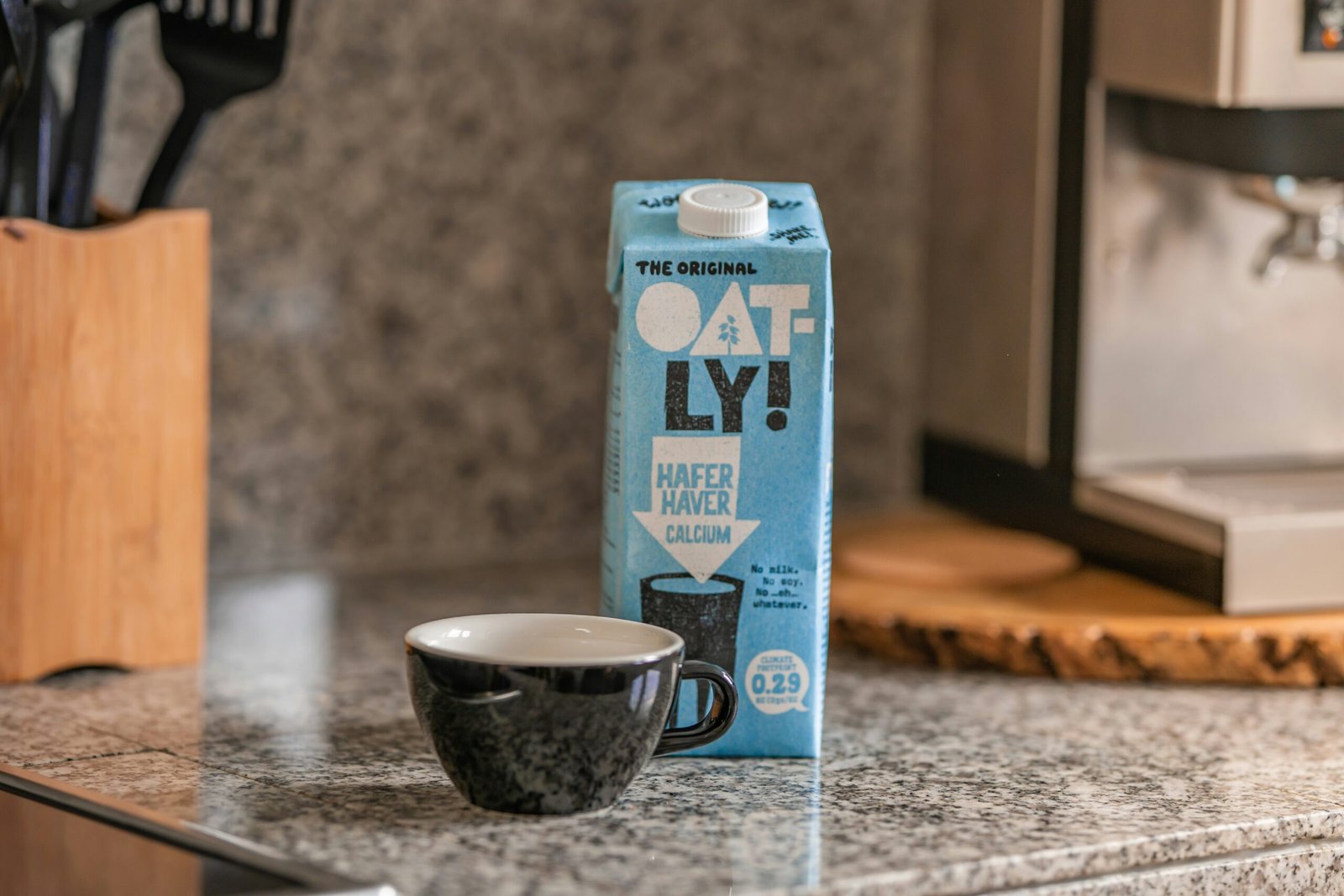Understanding Oat Milk: What Is It and Why Is It Popular?
Oat milk has emerged as a prominent alternative within the dairy market, gaining substantial traction among consumers in recent years. Originating from oats—cereal grains belonging to the family Poaceae—oat milk is produced by blending oats with water and then straining the mixture to obtain a creamy liquid. This formulation distinguishes it from traditional dairy products, providing a plant-based option for those who prefer or require non-dairy intake.
The rapid rise in oat milk’s popularity can be attributed to several factors. Primarily, it caters to consumers with dietary restrictions, such as lactose intolerance or dairy allergies. Many individuals are now avoiding conventional dairy due to health concerns or ethical considerations surrounding animal welfare. Oat milk stands out as a palatable substitute, boasting a naturally sweet flavor profile and smooth texture that resemble whole milk.
From a nutritional standpoint, oat milk is often fortified with essential vitamins and minerals, making it a robust contender among alternatives to dairy. Nutrition experts emphasize that it provides a source of fiber, beneficial for digestive health, while being lower in saturated fat compared to traditional milk. Additionally, there exists a notable distinction in environmental impact; oat milk generally requires less water and land for production than dairy. This sustainability aspect resonates with environmentally conscious consumers, thus amplifying its market presence.
For those seeking a plant-based lifestyle or simply exploring new dietary options, oat milk has proven to be a versatile ingredient, found in coffee, smoothies, and baked goods, further enhancing its appeal. With its careful balance of taste, nutrition, and ethical considerations, oat milk has indeed carved a significant niche in the ever-evolving dairy alternatives market.
Nutritional Comparison: Oat Milk vs. Cow’s Milk
When exploring the nutritional profiles of oat milk and cow’s milk, it is essential to consider several key components, including protein content, calcium levels, fiber benefits, and essential vitamins such as D and B12. Both types of milk provide unique nutritional advantages, making them suitable for different dietary preferences and health needs.
Firstly, protein is a significant concern for many consumers. Cow’s milk typically contains about 8 grams of protein per 8-ounce serving, providing a complete protein source with all essential amino acids. In contrast, oat milk usually contains around 2-4 grams of protein per serving. While oat milk has lower protein content, some brands fortify their products with additional protein sources to enhance their nutritional appeal. Hence, those requiring higher protein intake may prefer traditional cow’s milk.
Calcium is another crucial nutrient often associated with milk consumption. Cow’s milk is an excellent source of calcium, offering approximately 300 milligrams per serving, which is vital for bone health. Oat milk typically has lower natural calcium levels; however, many commercial oat milk variants are fortified with calcium, often matching or exceeding cow’s milk’s levels. This fortification can make oat milk an appropriate alternative for individuals seeking non-dairy options without sacrificing calcium intake.
Furthermore, the fiber content in oat milk presents an advantage over cow’s milk. Oat milk contains soluble fiber, which can contribute to improved digestion and support heart health. In contrast, cow’s milk lacks fiber altogether. For those looking to boost their fiber intake, oat milk can be a beneficial choice.
Lastly, regarding vitamins, cow’s milk is a natural source of vitamin B12 and vitamin D, both essential for maintaining overall health. Some oat milk products are fortified with these vitamins, making them suitable for vegans or individuals who are lactose intolerant, ensuring they can still receive adequate nutrition.
In conclusion, while oat milk and cow’s milk possess distinct nutritional differences, each provides unique health benefits. The choice between the two will largely depend on individual dietary requirements and preferences.
Potential Downsides of Oat Milk: Sugar and Nutrients
As oat milk gains popularity as a dairy alternative, it is essential to consider the potential downsides associated with its consumption, particularly concerning sugar content and nutrient profile. Many commercial oat milk brands add various sweeteners to enhance flavor, resulting in a product that can contain substantial amounts of added sugar. For individuals monitoring their sugar intake, it is crucial to read labels diligently, as some variants can contain sugar levels that rival those found in conventional sugary beverages. Frequent consumption of these high-sugar options may lead to excessive calorie intake, potentially increasing the risk of weight gain and related health issues, including type 2 diabetes.
In comparison, unsweetened oat milk options provide a viable alternative, delivering the oat-milk experience while significantly reducing sugar intake. Unsweetened varieties offer the creamy texture and pleasant taste without the adverse effects associated with high sugar consumption. Hence, consumers are encouraged to opt for unsweetened versions to minimize unnecessary sugar intake while enjoying their preferred dairy substitutes.
Another aspect to consider is the nutritional value of oat milk compared to traditional dairy milk. While fortified oat milk products often contain added vitamins and minerals, they may still lack essential nutrients found in cow’s milk such as calcium, vitamin D, and protein. Consequently, individuals relying solely on oat milk may find themselves missing out on vital nutrients that support overall health. It is advisable to complement oat milk consumption with other nutrient-rich foods or consider fortified options that address these gaps to ensure a well-rounded diet.
In conclusion, while oat milk can serve as a palatable alternative for those avoiding traditional dairy, its sugar content and potential nutrient deficiencies warrant careful consideration, emphasizing the importance of informed choices.
Making the Right Choice: Is Oat Milk Right for You?
When it comes to choosing between oat milk and traditional dairy products, personal preferences play a significant role. Oat milk, derived from whole oats, offers a creamy texture and a subtly sweet flavor, making it a popular choice for those looking for a plant-based alternative. However, individuals must consider their nutritional needs when deciding whether oat milk aligns with their dietary goals. Oat milk is typically fortified with vitamins and minerals, such as calcium and vitamin D, which can be beneficial for those who might not get enough from other sources.
One crucial aspect to consider is lactose intolerance. For individuals who experience discomfort with conventional dairy, oat milk presents a suitable alternative, allowing them to enjoy similar culinary experiences without the associated digestive issues. Additionally, those following a vegan diet can find oat milk an appealing choice, as it does not contain any animal products. However, it is essential to note that oat milk may not provide the same levels of protein as cow’s milk, which can be a concern for individuals relying on milk as a protein source.
Integrating oat milk into one’s diet can be straightforward and rewarding. It can be used in coffee, smoothies, or cooking recipes that require milk. Exploring various brands is advisable, as there can be significant differences in flavor and fortification levels. When selecting an oat milk product, look for options that are low in added sugars and contain whole oat ingredients. Also, consider your overall health conditions and dietary restrictions when making your choice. For some, oat milk may be the perfect addition to their dietary routine, while others may prefer sticking with traditional dairy products for their nutritional benefits.







